#Farming Efficiency
Explore tagged Tumblr posts
Text
Get the Best in Agriculture: Reliable Rotavator Components from Ludhiana
Agriculture is the backbone of our economy, and ensuring its success starts with reliable equipment. When it comes to sourcing durable, efficient, and high-quality rotavator components, SBJ Nirmal Products in Ludhiana stands out as a trusted name in the industry. In this blog, we’ll delve into what makes SBJ Nirmal Products the go-to choice for farmers worldwide.
Introduction to SBJ Nirmal Products and Its Mission
At SBJ Nirmal Products, our mission is simple yet impactful: to empower farmers with top-notch agricultural components that enhance productivity and minimize equipment downtime. With decades of expertise in manufacturing rotavator parts, we’re committed to quality, innovation, and customer satisfaction.
Why Choose Ludhiana for Agricultural Components?
Ludhiana, often referred to as the "Manchester of India," is a hub for industrial excellence. Its well-established infrastructure, skilled workforce, and commitment to quality make it the perfect base for manufacturing agricultural components.
A Hub of Quality Manufacturing: Ludhiana's factories are renowned for precision engineering and consistent quality.
Global Reach from a Local Base: From Ludhiana, SBJ Nirmal Products serves customers not only in India but also in Bangladesh, Nepal, Sri Lanka, and beyond.
The Importance of Reliable Rotavator Components
Reliable components are crucial for maximizing efficiency in agriculture. Here’s why:
Enhancing Agricultural Productivity: Quality rotavator parts ensure smooth soil preparation, leading to better crop yields.
Reducing Equipment Downtime: Durable components reduce the frequency of repairs, saving time and money.
SBJ Nirmal Products: A Legacy of Excellence
With over 4,500 rotavator parts in our portfolio, SBJ Nirmal Products has built a legacy of trust and excellence.
Trusted by Farmers Worldwide: Our components are designed to meet the diverse needs of farmers across the globe.
Key Features of Our Rotavator Components
At SBJ Nirmal Products, every component is crafted with precision and attention to detail. Here are some standout features of our rotavator parts:
Durability and Longevity: Built to withstand tough agricultural conditions, our components last longer, offering unmatched value.
Precision Engineering: Our parts are manufactured to exact specifications, ensuring perfect compatibility with a wide range of rotavator models.
Cost-Effectiveness: We provide high-quality products at competitive prices, making advanced agricultural technology accessible to all.
A Deep Dive into Popular Rotavator Components
Our extensive range of rotavator parts includes some of the most sought-after components in the market:
Crown Pinions: Designed for optimal torque and smooth operation, these are essential for high-performance rotavators.
Stub Axles: Known for their robustness, our stub axles ensure stability and reliability during field operations.
Rotavator Blades: Crafted from high-grade materials, these blades deliver efficient soil cutting and mixing, enhancing field preparation.
SBJ Nirmal’s Commitment to Quality and Innovation
Quality and innovation are the cornerstones of our manufacturing process. Here’s how we ensure excellence:
ISO-Certified Manufacturing Processes: Our production facilities adhere to the highest international standards.
Use of Advanced Technologies: From CAD design to CNC machining, we leverage cutting-edge technology to deliver superior products.
Sustainable Practices in Component Manufacturing
We are dedicated to sustainable manufacturing practices that benefit both the environment and the community:
Eco-Friendly Materials: Our components are made using materials that are sustainable and recyclable.
Minimizing Waste and Maximizing Efficiency: Advanced manufacturing techniques help us reduce waste and optimize resource use.
Testimonials: Farmers Speak About SBJ Nirmal Products
Our commitment to quality and service has earned us glowing reviews from farmers worldwide:
Real-Life Stories of Success: Many farmers have shared how our rotavator parts have transformed their operations.
Positive Feedback from Around the Globe: From India to Nepal, our customers praise the durability and efficiency of our products.
How to Purchase from SBJ Nirmal Products
We make it easy for farmers and dealers to access our products:
Online Ordering Options: Our website offers a seamless ordering experience, complete with detailed product descriptions and specifications.
Dealer Networks in India and Beyond: Our extensive network ensures prompt delivery and reliable after-sales support.
Conclusion: Elevate Your Farming Efficiency with SBJ Nirmal Products
When it comes to reliable, high-quality rotavator components, SBJ Nirmal Products in Ludhiana is a name you can trust. With a legacy of excellence, a commitment to innovation, and a focus on sustainability, we are dedicated to empowering farmers worldwide. Choose SBJ Nirmal Products and experience the difference in agricultural efficiency and productivity.
#rotavator components#reliable agricultural parts#SBJ Nirmal Products#rotavator parts manufacturer#Ludhiana agricultural parts#high-quality rotavator components#durable rotavator parts#precision engineering in agriculture#cost-effective rotavator parts#crown pinions#stub axles#rotavator blades#sustainable manufacturing#ISO-certified rotavator parts#global rotavator parts supplier#rotavator parts in India#buy rotavator components online#agricultural productivity#farming efficiency#trusted rotavator parts
0 notes
Text


Look me in the eyes and tell me Prowl’s autistic ass WOULDNT play the shit outta Minecraft
Chicken Jockey 🐓🏇
And then Prowl paid him keep quiet
#art#digital art#transformers#transformers g1#transformers generation one#transformers jazz#transformers prowl#jazzprowl#he would ABSOLUTELY commit war crimes in Minecraft (it’s very efficient)#his base is full of morally corrupt farms 😔#how ironic would it be if jazz was terrible at Minecraft and Prowl knows everything about it#PLEASE LAUGH
3K notes
·
View notes
Text

[ID: Ask from @storiesandsquirrels, transcribed in alt text]
also: link to Cow Lore
There's one major misconception here I've gotta correct before answering earnestly; Holsteins do need Super Duper Food. This is one of their major problems as a breed, you need to give them high quality feed for high quantity, low quality milk.
But! That said! These are valid questions that deserve real responses. In spite of the quick correction, I actually want to answer them as you phrased them because I think it would be more illuminating. I'm going to try and summarize them as I go along;
Question 1: "Why wouldn't we want to use The Most Efficient Cow?"
The simplest answer is disease. My ""prediction"" came true, and bird flu has mutated to spread extremely easily through the infected udders of Holsteins. No one has died of bovine-contracted HPAI yet, but with Brainworm Bobby and his love of raw milk in charge of the CDC...
well. my last prediction was prophetic. let's hope this one's not.
Minmaxing a breed for one specific purpose always means intensive inbreeding. Like I mentioned, 9 million Holsteins are genetically equivalent to 60 individuals. A more genetically diverse population is one that will be better at preventing disease outbreaks, and reducing their severity when they do.
And what even is the Most Efficient Milk Cow? If you're only selecting for pure milk production to drive down its cost, you get a breed of cattle that lacks every other important trait that would make it good livestock;
They get sick more often, due to inbreeding depression and lack of physical fitness, requiring more antibiotics and veterinary care.
They are bad parents who will need more human intervention to birth and raise calves
They won't be good grazers, meaning they need a specific food grown for them, increasing how much "functional" land is actually dedicated to cattle husbandry.
Their carcass won't yield as much meat, so more cattle have to be raised and slaughtered to meet demand.
Their bodies will burn out much quicker than a healthier animal, meaning you need to replace your livestock more often.
When it comes to living beings, "efficiency" is "fragility." It's not a stable system to begin with.
Even with the pure logic aside, just, step back here and look at the situation with a heart. We'd be making unhealthy, short-lived animals lacking critical instincts to lead good social lives. AND we probably haven't even fixed the "less land" problem, just shifted the land off-site.
For what? For more milk? We have SO MUCH milk we don't even know what to do with it!
Question 2: "Isn't an overabundance of cheap milk a good thing?"
no.
Under the infinite genius of Capitalism, thousands of gallons of milk just gets poured into the sewer daily because there's too much of it. Transporting it to a processor would cost more than it's worth, sometimes the processors turn milk away because they don't want to overproduce products, and even the US government can't subsidize every last drop; it still has 1.4 billion pounds of cheese in various caves and warehouses across the country.
The price of milk cannot get any lower because it's already being sold below the cost it takes to produce it, and yet, we're still here literally pouring it down the drain.

[photo from bill ulrich who photographed a farmer dumping milk back during the pandemic. this isn't even a recent photo. this happens every time there's a milk surplus. im using this photo because i like the farmer's cunty little pose. look at him. "just ain't right"core.]
And milk being dumped into the sewer is more than just wasteful. It's a biohazard.
Milk doesn't stop rotting when it's dumped. If you live downstream of a milkhouse, improper milk disposal reeks.
It's full of nutrients, too, which causes diatoms, cyanobacteria, and other types of algae to go into overdrive-- causing a Harmful Algal Bloom event in the water, or HAB.
HABs are horrific. There's HUNDREDS of different types. They can suck up oxygen and create "dead zones" which kills all aquatic life, they can poison the water supply for an entire town, and some can even cause toxic fumes that make it hard to breathe on land.
Now, listen, I don't want to scare you into never dumping out rotten milk or anything! It's that on an industrial scale, it's REALLY REALLY bad if a farm overproduces milk-- especially crummy milk that can't be made into decent cheese or other dairy products.
In fact, if we did produce milk on a smaller scale, it would be better for everyone! Unless you're a Milk Guzzling Fiend like I am, you probably wouldn't need to buy a whole gallon at a time. In countries like Italy, it's sold fresh and in smaller containers, and you're just expected to pick it up as you need it.
This is why milkmen used to exist, and still do in places that are cool; they'd deliver your supply fresh from the creamery. Less waste, less stress! The "subscription model" is actually sooooooooooo much better for milk production, since it helps to stagger out those "surges and drops" of demand that leads to milk dumps.
Question 3: "If the cow eats less, doesn't that mean less land for pasture, which is a good thing?"
There's a lot to unpack within this sentiment. It's actually based on a couple of common assumptions on a few levels, which are incorrect in fascinating ways. Challenging this means opening up your worldview on how complex keeping livestock actually is!
I'll start with the simpler part;
You could cut fresh pasture out of the equation entirely and shove a cow into a concrete pen with a food box-- but are you counting the land growing the fodder?
When you grow corn the way that we do on industrial farms in the US, it's unbelievably destructive. Unending oceans of monoculture. Fogged with pesticide, pumped full of fertilizer which causes HABs like dumped milk does, sprayed with thousands of gallons of wasted water.

When you look at this image, I need you to understand you are looking at a dead zone. Like a suburban lawn, just because it's green doesn't mean it's good. Nothing grows here but corn and pests of corn, which gets poisoned and dies without returning any of that energy to the ecosystem.
This is usually what is being given to "grain-fed cattle," either when they're sent to a feedlot to hit their slaughter weight, or when they're lactating so they need the extra nutrition. It's also so nasty it's inedible to human beings.
Now, a lot of cattle farmers will just supplement their cow's diet, doing a mix of pasture feeding (much cheaper) and grain feeding (quicker gains). But the facts on this are clear; pasture-kept cattle result in LESS emissions and need LESS total space than cows in confinement.
In fact, there were a LOT of benefits!
Overall gas emissions from the cows dropped by 8%
Ammonia pollution was down by 30%
Not needing to run farm equipment for fodder planting and harvest reduced carbon dioxide emissions by 10%
Rotated crop fields didn't sequester carbon; but the newly converted perennial grasslands store as much as 3,400 pounds per acre.
The outside cows did produce less milk volume, but the milk they did produce was higher quality. So, looking at all the benefits here, it's clear that pasture is actually something that should be embraced for ecological reasons, not rejected.
In FACT, it should be EMPHASIZED. Because, this is the mind-blowing part,

Pasture can ALSO be an ecosystem.
In fact, I'm a Warrior Cats guy who once did a deep dive on moorlands just so I could write WindClan better. There are entire biomes that only exist because of grazing, and British lowland heath is one of them!
Keeping cattle in a sustainable, ecologically sound way is going to look different depending on where in the world you're doing it. So many earnest, good-willed people have bought into the lie that humans are a problem, and that everything "associated" with us becomes a barren wasteland as if we are tainted. YOU are not the problem! The problem is, and always has been, exploitation. Unsustainable relationships with the land we're part of.
Indigenous people in Europe, Asia, and Africa have been keeping cattle for thousands of years. In North America, cattle can be used to maintain ecosystems that have been badly affected by the colonial eradication of the American Bison. In South America, Brazil specifically has been making incredible advances with highly efficient integrated crop-livestock-forestry farming.
Generally, pastures here in the US are not as intensely managed as an equivalent crop field. Some people fertilize them, or water them mid-summer, but absolutely not to the same extent as industrial corn farms. Cattle are typically rotated between pastures, allowing each to re-grow before they come back to graze again.
Obviously, yes, overgrazing can be an issue. Not every open space should be converted into a pasture, and the destruction of other environments to turn into cow land is a problem. But that is an issue of bad land stewardship, not the mere practice of keeping livestock.
Bottom line, though? Cattle who can graze and survive outside are better for the environment than cattle that can't.
...but hey, you know what Holsteins happen to be really bad at?
EVERYTHING. GRAZING.
They are notoriously terrible grazers. They can't do megan THEEEEE thing that cows are known for. Fragile frames, a lack of fat to keep them warm outside, increased demand for food, distaste for any rough forage, horrible mothering instincts, the list goes on. Holsteins are a NIGHTMARE to try and keep outside all year round compared to other breeds.
(especially heritage breeds, like the Milking Devon, Florida Cracker, or Texas Longhorn. Between these three, you'd be totally covered in 80% of American climates.)
I've already explained why it's not actually very good or important that we minmax milk volume, but even if that was actually something we should value, there are so many downsides that they would absolutely not be the dominant cow breed in a truly "efficient" system.
"Less cows means less cow food and cow land" is sound logic, but Holsteins are not the right cow for that job.
Question 4: "How could this be done in a way that doesn't increase cost of living?"
I'm not sure how to answer this question, simply because I'm not Bonestar, Leader of AmericaClan. Wish I was. I would rule tyrannically.
It's worth noting that Brazil is the second largest producer of beef in the entire world, AND the number one largest exporter of it, AND only puts 30% of its land to total agricultural use. The USA dedicates over 50%. And also Brazil is net reducing its amount of agricultural land while increasing output.
It seems clear to me that the USA actually has a massive food waste and resource distribution problem, to the point where the price we pay for stuff is actually wildly disconnected from the actual value of the goods and labor.
I think the way that us Americans tend to frame our conversations on these topics as "growth" vs "cuts" instead of asking how to minimize waste by making existing systems more efficient prevents us from solving problems. We're also just... really culturally resistant to the idea of anything being more "expensive," even if it ends up costing us a lot more money in waste or mismanagement later.
Penny wise and dollar foolish ass country.

Question 5: "What can we personally do about this?"
I mean, I wasn't making a call to action in Cow Lore, I was just explaining to one of my regulars why I don't like Holsteins LMAO. Since you're asking though...
I don't think we can change the wider trend in the dairy industry without actual government intervention and regulation, though, and that's very unlikely in the current political environment. they just sent random dudes to Ausalvador-Birkenau and when the Supreme Court said "bring this specific person back" they said "nuh uh." fellas I don't think we're getting better dairy regulations in the foreseeable future.
So I think the most productive thing to do is focusing on supporting small farms and heritage breeds. Get involved in your community garden or heritage society if you have one.
Not only is that generally a very rewarding thing, but it will be helpful to you in case The Situation Gets Worse. Knowing your neighbors and having real human connection is your best defense against economic recession.
Supporting the locals is always a great thing to do, which can be as simple as going to farmer's markets. You don't need to buy fancy food every day to make an impact on your community-- it can be a treat sometimes!
You could also subscribe to the Livestock Conservancy's free newsletter, where they talk about the work they're doing and upcoming events. If you're a knitter, crocheter, or any other kind of fiber artist, you could even join in on a challenge they're running where you make items out of rare wool for prizes!
Should you end up liking the work they do, you can become a member for 4$ a month, or go to one of their educational events.
Even just talking about the problem can do a lot! Did you know the Highland Cow was actually critically endangered in the USA within the past 10 years? It was the work of the Livestock Conservancy, plus a surge in their popularity, that helped to bring their numbers up. Word of mouth is a powerful thing.
All that said, remember, you can't solve every problem. It's a big world and there's a lot of them. Being made aware of an issue doesn't mean you have to drop what you were previously doing-- just care a lot about something that you want to improve, and let that guide you.
#Funfact: My great-something-grammy boinked the milkman#and that's how my great-something-grandparent happened lmaoo#Straightup parody level family drama#queen behavior tho ngl#Perhaps I simply respect my Milkmancestor's game too much#got milk in my blood#bone babble#cows#i like. tried not to say it TOO much besides the powerpuff girls meme. but.#capitalism is the core problem under everything here#it doesn't actually encourage efficiency on a large scale; it *encourages* overproduction and *incentivizes* artificial scarcity#under a capitalist system it is a good thing to crush your small farm competition by literally flooding the market with cheap milk#because it's more profitable to dump sour milk onto the nearest poor community than lose sales to Meemaw Moomoo And Her Heritage Herd#and yeah the cows are sick and dying from genetic issues and infections. but it's cheaper to feed them antibiotics#because it's not like the dairy industry is the one who pays for the medical care of antibiotic-resistant superbugs that jump to humans!#the questions were genuine tho so I was trying to answer them without a Degrowth Rant lmaooooooooooo#will say as an aside though that when Cost of Living comes up as a concern there's a red part of me that is like#''comrade. ANY cost to live is too high.''
256 notes
·
View notes
Text
Dandelion News - February 8-14
(I’m finally starting to get better from having had pneumonia for 2+ weeks, hopefully next week’s news should be on time)
Like these weekly compilations? Tip me at $kaybarr1735 or check out my Dandelion Doodles!
1. Solar-powered device captures carbon dioxide from air to make sustainable fuel

“[The] solar-powered reactor could be used to make fuel to power cars and planes[.… It] does not require fossil-fuel-based power, or the transport and storage of carbon dioxide, but instead converts atmospheric CO2 into something useful using sunlight.”
2. How artificial light can boost coral reef recovery

“UZELA is [an autonomous submersible] designed to attract zooplankton […] by emitting specific wavelengths of light. [… In a ”six-month testing period,” it] significantly increased local zooplankton density and boosted the feeding rates of both healthy and bleached coral.”
3. Next-gen solar cells now fully recyclable with water-based method

“The recycled solar cell has the same efficiency as the original one. The solar cell is made of perovskite and the main solvent is water. […] They are not only relatively inexpensive and easy to manufacture but also lightweight, flexible and transparent.”
4. Green walls cool cities and create urban habitats

“The researchers measured a cooling effect of up to 0.6–0.7 degrees Celsius [… which] could help combat the urban heat island phenomenon. […] The researchers [also] found that plant-covered facades hosted over 100 animal species, including insects, spiders, and birds.”
5. Major cause of honeybee mortality can be easily reduced

“If treatment occurs too soon, it may not fully eliminate the mites, allowing them to rebound before the season ends. […] Similar to antibiotic-resistant bacteria, mites that survive mistimed or improperly applied treatments become more resistant to future applications.”
6. Uganda community group restores shea groves and livelihoods
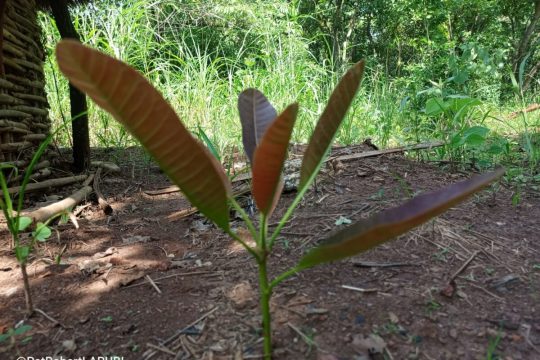
“As part of a larger effort to restore Uganda’s shea parklands, the cooperative has successfully rehabilitated more than 500 hectares (1,240 acres) of degraded land, integrating shea trees (Vitellaria paradoxa) and other native species with maize and sunflower crops.”
7. Senate Renews Commitment to the Great Lakes

“The [Act] represents the most significant federal investment in the health of the Great Lakes, addressing critical challenges such as pollution, invasive species, and habitat restoration. The Great Lakes […] hold 20 percent of the world’s surface freshwater[….]”
8. Earth Gets Its Largest Protected Tropical Forest Reserve

“The Kivu-Kinshasa Green Corridor will […] protect 108,000 square kilometres of primary forest and support 60 million people who depend on the forest for food, energy and jobs. […] Through this approach, the DRC is empowering local communities to protect the forest while fostering economic growth.”
9. Australia’s Rarest Bird of Prey Spotted in Central Australia After 30 Years

“Dr. Henderson’s finding is an encouraging sign of the health of the sanctuary’s ecosystems as well as the bird’s continued migration into new areas. This bird’s presence in the sanctuary is particularly significant as it is the first confirmed sighting in the region since the mid-1990s.”
10. Australian company wins contract to design “hydrogen ready” high speed ferry

“The ferry, the Horizon X, will have capacity for 1,650 passengers and 450 cars, and will be able to travel at a speed of up to 35 knots. […] The ship will also have a specially-designed propulsion system arrangement that repurposes exhaust from the engine to help propel the vessel, in theory reducing its emissions.”
February 1-7 news here | (all credit for images and written material can be found at the source linked; I don’t claim credit for anything but curating.)
#hopepunk#good news#solar power#sustainability#carbon capture#technology#coral reef#ocean#solar panels#solar energy#recycling#green infrastructure#urban heat#urban#biodiversity#honey bees#beekeeping#africa#farming#great lakes#us politics#conservation#nature#australia#birds#endangered species#transportation#ferry#boat#energy efficiency
103 notes
·
View notes
Text
DESMOND HAS TERRIBLE TASTE IN FOOD
He drinks his coffee black, not for the energy or to be pretentious, but just because he genuinely fucking prefers it that way. He prefers the taste of strong alcohol, give him a can of 4loko, and he will drink it like plain water. He eats overly spicy food (like so spicy it just straight ruins the flavor), not even just because he has a high spice tolerance, just because he likes it???? He eats canned soup straight out the can without even heating it up, actually, he refuses to heat up any kind of leftovers and just eats them cold even if it's something that absolutely should not be eaten cold. Everyone refuses to eat at his house after they saw him throw back a can of cold baked beans without even blinking.
#is this because the food from the farm was dry and tough so thats what hes used to??#....perchance#this is most prevalent with coffee#the other assumed he was just being edgy and pretentious at first#but then they realized he was just like that???#like he genuinely enjoyed drinking his coffee like that#they refuse to let him into the kitchen#oh and it only got worse after he went through altair's memories#altair who eats for energy and efficiency and nothing else#yeah he totally picked up altair's bad eating habits along with his shitty taste#assassin's creed#desmond miles#silly desmond#desmond
102 notes
·
View notes
Text

I take all my lil FoM farming quirks, and pack it into one green haired lady
#Her farm is built for EFFICIENCY#Both her home and farm are so ugly with all the decor shoved in the corner#my art#original character#oc#fields of mistria oc#fields of mistria#fom#fom oc
17 notes
·
View notes
Text


literally has only one skill to me
#i have nothing to say about him#made him for farming and farming only#full 75% efficiency let's go#also gives apex revenant vibe tho#oh and he kinda has 6 fingers#there's something spiking out next to his little finger#huh#warframe#warframe nekros#my art
56 notes
·
View notes
Text
USDA Ordered to Restore Terminated Grants to Farmers, Nonprofits



#department of government efficiency#elon musk#usda#department of agriculture#agriculture#farming#ranch life#federal funding#government spending#donald trump#trump administration#federal government#republicans#gop#democrats#civil rights#social justice#us politics
4 notes
·
View notes
Text
oh ya sneeg and co are taking a longer time to level potions but its just bc theyre using health pots instead of turtle lmao
#liveblogging#the realm liveblogs#dtowngato jan. 10 | alchemy grind!! the realm smp#i think sneeg's farm is more efficient For what they're doing (health pots) but if they did more turtle it'd prob be abt the same
9 notes
·
View notes
Text

Why SBJ Nirmal L Type 14x57 Rotary Hoe/Blade is the Ideal Choice for Farmers
When it comes to preparing soil and ensuring crops have the best start possible, farmers know that quality tools make all the difference. The right rotary Hoe/Blade can mean the difference between smooth soil preparation and days of unnecessary struggle. That’s where SBJ Nirmal L Type 14x57 Rotary Hoe/Blade comes in. With its efficient design and high-quality materials, this blade is made to withstand the challenges of modern farming. Let’s dig deeper into why this blade is so special and what sets it apart in the world of agricultural tools.
What is a Rotary Hoe/Blade, and Why is it Important?
A rotary Hoe/Blade is a critical part of a rotavator, a piece of farming equipment used to break up and aerate the soil. In simple terms, a rotary Hoe/Blade spins into the ground, digging up soil to prepare it for planting. This process helps improve soil structure, aerates it for plant roots, and controls weeds—all vital aspects for healthy crop growth.
The L-shaped design of the SBJ Nirmal 14x57 blade makes it especially effective at penetrating soil. Its unique shape allows the blade to dive deep into the ground with each pass, giving a more thorough till. Whether you’re dealing with compact, rocky, or sandy soil, this blade is built to handle it. Many farmers appreciate this blade because of its ability to handle different soil types without losing efficiency.
Made from Boron Steel: Built to Handle Tough Jobs
One standout feature of SBJ Nirmal L Type 14x57 Rotary Hoe/Blade is the boron steel material it’s crafted from. For those unfamiliar with boron steel, it’s a high-strength steel alloy that includes a small amount of boron. This might seem like a minor addition, but that tiny amount of boron gives the steel incredible strength, hardness, and durability. Farmers benefit from boron steel because it makes the blade tough enough to withstand harsh soil conditions.
Here’s a bit more on boron steel’s advantages:
High Hardness and Strength: Boron gives steel an extra level of hardness and wear resistance. Since farming equipment often takes a lot of punishment, this extra hardness is a huge plus, meaning less wear and fewer replacements.
Resistance to Abrasive Soils: In areas with rocky or gritty soil, blades can wear down fast. Boron steel holds up well against abrasive materials, allowing it to dig deeper and last longer than standard steel.
Great Flexibility: Even though it’s hard and strong, boron steel maintains a level of flexibility. This balance is crucial since overly rigid materials can break under heavy stress, but boron steel can bend without snapping.
With boron steel, SBJ Nirmal blade provides a mix of strength and endurance that most standard blades lack. Farmers who use it report longer life spans for their blades, reducing the need for frequent replacements.
Powder Coating: Protecting the Blade Against Rust and Wear
On top of using durable boron steel, SBJ Nirmal adds a powder coating to its L Type 14x57 Rotary Hoe/Blade. This is a special process where a powder made of resin, pigment, and other particles is applied to the blade’s surface, then heated to form a strong, protective layer. The result is a coating that protects the blade from rust, moisture, and other weather-related damage.
Powder coating is an important feature for a few reasons:
Rust Resistance: As any farmer knows, equipment that stays outdoors is prone to rust. The powder coating provides an extra layer of protection, keeping the blade rust-free and extending its lifespan.
Weatherproofing: From rainy seasons to dry spells, farm equipment faces a range of weather conditions. Powder coating prevents moisture from seeping into the metal, so the blade doesn’t corrode or degrade.
Easy Maintenance: Powder-coated blades are much easier to clean, requiring only a quick rinse to remove dirt or mud. This saves time for busy farmers who want reliable, low-maintenance equipment.
Key Benefits for Farmers Using SBJ Nirmal 14x57 Rotary Hoe/Blade
So, why do farmers trust this particular blade for their rotavators? Here are some of the top reasons this blade has become a popular choice:
Efficient Soil Penetration: The L-type shape is optimized for soil penetration. Its angled edges dig in smoothly, so the blade can handle dense soil without wearing down quickly. This shape also makes it easier to prepare seedbeds with fewer passes, which is a big time-saver.
Versatility Across Soil Types: One major benefit of SBJ Nirmal L Type 14x57 blade is its versatility. Farmers use it successfully on everything from clay-rich soil to sandy ground, as well as rocky areas. This versatility means farmers don’t need different blades for different fields.
Cost-Effective Over Time: Since it’s built to last, this blade is a good investment. The initial cost may be a bit higher than standard blades, but over time, farmers save on replacements and repairs. For those managing large areas or frequent tilling, this long-lasting blade proves especially economical.
Low Maintenance Requirements: With the combination of boron steel and powder coating, this blade is tough and easy to care for. It can handle wet, muddy fields without rusting or degrading, meaning it’s always ready for the next job.
SBJ Nirmal: A Brand Farmers Trust
SBJ Nirmal Products has earned a reputation as a reliable supplier of high-quality rotavator parts. The company’s commitment to quality is clear in every part they produce, especially in their L Type 14x57 Rotary Hoe/Blade. They’re known for their consistent focus on durability and performance, ensuring farmers have tools they can rely on year after year.
In the end, SBJ Nirmal L Type 14x57 Rotary Hoe/Blade is an ideal choice for farmers looking to optimize their soil preparation process. It combines strength, resilience, and smart design, all essential features for today’s agricultural needs. By investing in a blade built to last, farmers can spend more time focusing on their crops and less time worrying about tool maintenance.

#Rotary Hoe Blade#SBJ Nirmal Products#L Type 14x57 Blade#Boron Steel Blade#Powder Coated Blade#Durable Farming Tools#Soil Preparation#Rotavator Parts#Agricultural Equipment#Farming Efficiency#Rust Resistant Blade#High-Quality Rotary Blades#Long-Lasting Farming Tools#Efficient Soil Cultivation#Weed Control Blade
0 notes
Text
Inside a Cow's Stomach: The Microbial Magic Behind Milk
Cows Rely On Their Rumen Microbiome To Digest Food And Produce Milk Efficiently. Understanding These Microbes Could Help Revolutionize Dairy Farming.
— Laura Tran, PhD | July 30, 2025

Researchers study how microbes move around the farm and their influence on milk production and efficiency in cows. Image Credit: © iStock, Clara Bastian
t all starts with a cow. These gentle, grass-chewing giants are the foundation of an entire food system built on milk. When a dairy cow becomes pregnant around one year of age, she begins a biological journey that fuels one of the most diverse categories in people’s diets. After a nine-month gestation period, she gives birth to a calf and begins producing milk. This lactation cycle typically lasts about a year and is central to dairy farming operations.
But cows aren’t the only vital players in this story, because microbes are just as essential. Dairy cows have a specialized organ called the rumen, which contains a vibrant community of microbes that help break down the cows’ feed of corn silage to soy to alfalfa. “What happens is the microbes, through the bacteria, will then physically attach, break down cellulose, hemi-celluloses, and ferment them into volatile fatty acids,” explained Garret Suen, a rumen microbiologist at the University of Wisconsin-Madison, during a session at the American Society of Microbiology Microbe 2025 meeting. These volatile fatty acids affect milk production and composition.
To meet the growing needs of consumers, farmers have primarily used breeding strategies to obtain larger cows that produce more milk or have altered the cows’ diet; however, milk quality is just as important as the quantity. “You want milk fat, you want milk sugars, and you want protein [in milk],” said Suen. However, he remarked that of these approaches, “the rumen microbiome has been largely ignored, even though people know that it is the big thing that drives most of this [production].”
Although many assumed that the rumen microbiome was indeed a driver of milk production, Suen noted that few have provided evidence of this. The rumen microbiome is challenging to study due to its anaerobic environment. However, technologies such as next-generation sequencing have helped researchers begin to characterize and understand the microbial diversity in the rumen. In 2017, Suen and his team found that there were distinct microbiomes between high- and low-efficiency dairy cows, but this list of microbes didn’t tell the researchers much else.1
To further explore this association, Suen and his team performed a classic transplant experiment by taking the rumen microbiome of a high-efficiency cow to give to a low-efficiency cow and vice versa.2 They did this using three pairs of cannulated cows, which have a surgically inserted port in their side that enables researchers to access the rumen and its contents. “What we did was we, by hand, stuck [a] hand into the rumen, and we basically grabbed contents and stuck it into a giant garbage pail. We did this for all six of these animals, and then we stuffed the [donor] rumen contents back into their associated pair.”
The researchers assessed the microbial communities in cows before a rumen content swap and over eight weeks, using 16S rRNA and amplicon sequencing to monitor changes. They observed that low-efficiency cows temporarily became high-efficiency about a week after receiving rumen content from high-efficiency donors, but they eventually reverted to their original, low-efficiency state. In contrast, high-efficiency cows that received rumen from low-efficiency counterparts lost their productivity and never regained it.
“This suggests that modifying the adult rumen microbiome is going to be rather challenging,” said Suen. “Because if these animals have the ability to kind of correct their microbiome even after wholesale changes at this level, that’s going to make significant changes really difficult.”
To overcome this, Suen and his team turned their focus to calves, aiming to influence milk production early in life by shaping the microbiome themselves. Since dairy calves are often separated from their mothers at birth and raised by humans, they are likely to acquire their gut microbes from the environment.3 The team collected rumen contents from adult cows and administered them to calves from birth to six weeks of age.4 Later, as adults, these cows were cannulated and their microbiomes sequenced. While clear differences were observed between the microbiomes of high- and low-efficiency cows, these changes did not result in any measurable improvements in milk production.
While Suen continues investigating the factors that influence microbial movement across farms, he and his team have adopted less labor-intensive methods for sampling the rumen.5 One recent approach involves using oral swabs, which can detect up to 70 percent of the rumen microbiome. Compared to traditional sampling techniques, the researchers found that oral swabs successfully mirrored the microbial associations observed previously. As Suen and other scientists delve deeper into how microbes influence productivity on dairy farms—for cows and other ruminant animals like goats and sheep—they're also examining how farmers can meet the growing demand for milk in more sustainable ways.
#Cow 🐄#Dairy#Microbiology#Microbiome#Milk 🥛#Next Generation Sequencing#Cow's Stomach#The Microbial Magic Behind Milk#Rumen Microbiome#Digest Food#Produce Milk Efficiently#Revolutionize#Dairy Farming
3 notes
·
View notes
Text
Good News - May 22-28
Like these weekly compilations? Support me on Ko-fi or $Kaybarr1735! Also, if you tip me on Ko-fi or CashApp (and give me some way to contact you if it doesn’t automatically), at the end of the month I'll send you a link to all of the articles I found but didn't use each week - almost double the content!
1. Scientists Invent Healthier More Sustainable Chocolate
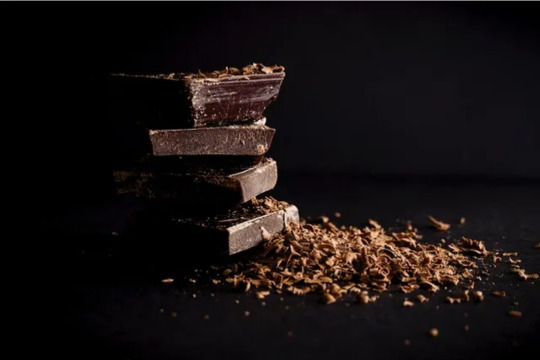
“The new chocolate recipe from researchers at ETH Zurich uses more materials from the cocoa pod that are usually discarded, including more of the pulp as well as the inner lining of the husk, known as the endocarp. […] The resulting chocolate also [was “deliciously sweet” and] had 20% more fibre and 30 percent less saturated fat than average European dark chocolate[, and] it could enable cocoa farmers [to] earn more from their crops.”
2. Vermont Is Coming for Big Oil, Making It Pay for Decades of Climate Pollution

“Legislators in Montpelier are on the brink of enacting the "Climate Superfund Act," modeled after the federal Superfund law, that seeks to make oil, gas and coal companies pay for damages linked to historical greenhouse gas emissions. […] Companies would be held liable for the costs associated with […] floods and heat waves, along with losses to biodiversity, safety, economic development and anything else the treasurer deems reasonable[, that were caused by their emissions].”
3. Important bird habitat now protected in the Rocky Mountain Trench
“Grassland-reliant species in the Rocky Mountain Trench now have more protected habitat thanks to a new [270-hectare] conservation area near Cranbrook. […] About one-third of the Skookumchuck Prairie Conservation Area is forested[…,] Most of the site is a dry grassland[…, and] Three hectares of wetlands add to the landscape diversity and offer crucial benefits to wildlife and water systems in the area. This conservation gem also provides habitat for endangered American badger and excellent winter range for elk, mule deer and white-tailed deer.”
4. Lemur Week marked by 70th breeding success
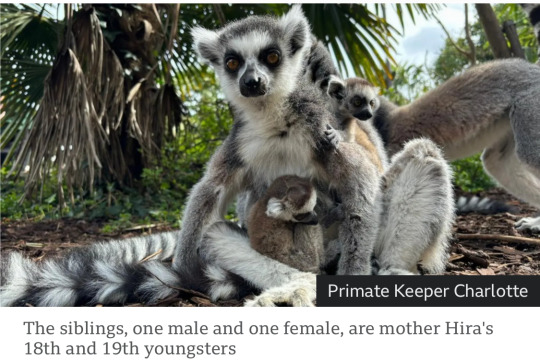
“A wildlife park has celebrated its 70th lemur breeding success ahead of a week raising money to help save the endangered primates. […] The park's open-air Madagascar exhibit is home to 31 free-roaming lemurs and was officially opened in 2008. […] Females are only sexually receptive for just one or two days a year, leaving a small window of opportunity for males to father offspring. […] The two playful siblings, one female and one male, were born to father Bernard and mother Hira.”
5. Innovative material for sustainable building
“Researchers introduce a polymer-based material with unique properties. This material allows sunlight to enter, maintains a more comfortable indoor climate without additional energy, and cleans itself like a lotus leaf. The new development could replace glass components in walls and roofs in the future.”
6. Isle of Wight eagles don't pose threat to lambs as feared

“While there had previously been fears that the eagles would feed on livestock, such as lambs, the project has found no evidence of this. [… “W]hite-tailed eagles effectively steal meals from other predatory birds[, which is] a really important ecological role that had been lost within the landscape and is being restored.” [… The birds’] population was boosted by a chick last year – the first time the species has bred in England in 240 years.”
7. Breakthrough discovery uses engineered surfaces to shed heat
“Cheng's team has found a way to lower the starting point of the [Leidenfrost] effect by producing a surface covered with micropillars. […] The discovery has great potential in heat transfer applications such as the cooling of industrial machines and surface fouling cleaning for heat exchangers. It also could help prevent damage and even disaster to nuclear machinery.”
8. New malaria vaccine delivered for the first time
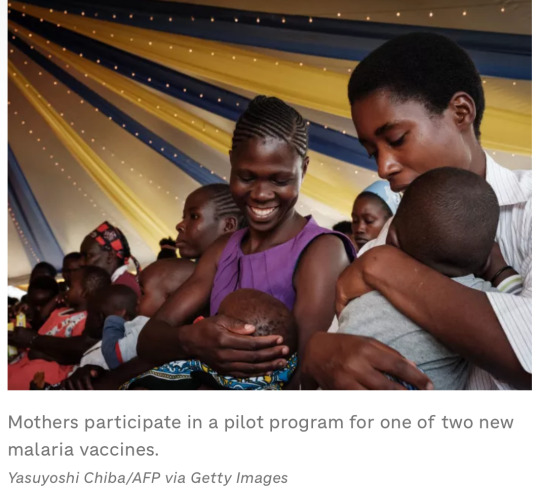
“A total of 43,000 doses arrived by air today from UNICEF, and another 120,000 are scheduled to show up in the coming days. […] They're the first vaccines designed to work against a human parasite. […] Across four African countries, these trials showed a 75% reduction in malaria cases in the year following vaccination of young children. […] The Serum Institute of India, who will be manufacturing the new vaccine, says a hundred million doses will likely be available to countries by the middle of next year.”
9. Urban gardening may improve human health: Microbial exposure boosts immune system
“"One month of urban indoor gardening boosted the diversity of bacteria on the skin of the subjects and was associated with higher levels of anti-inflammatory cytokines in the blood. The group studied used a growing medium with high microbial diversity emulating the forest soil," [… whereas] the control group used a microbially poor peat-based medium. [… N]o changes in the blood or the skin microbiota were seen. […] “This is the first time we can demonstrate that meaningful and natural human activity can increase the diversity of the microbiota of healthy adults and, at the same time, contribute to the regulation of the immune system."”
10. Cities Are Switching to Electric Vehicles Faster Than Individuals

“[M]ost large cities have adopted some kind of climate goal, and some of them are buying EVs for their municipal fleets at a faster rate than the general public. And that progress could speed up as more EVs enter the market and as cities get educated about grant funding and tax incentives that were passed over the last four years.”
May 15-21 news here | (all credit for images and written material can be found at the source linked; I don’t claim credit for anything but curating.)
#hopepunk#good news#chocolate#sustainability#farming#health#vermont#big oil#oil companies#climate change#cooling#technology#nuclear#malaria#vaccine#africa#unicef#eagles#livestock#england#birds#electric vehicles#glass#energy efficiency#habitat#conservation#lemur#zoo#gardening#urban gardening
355 notes
·
View notes
Text
kentareo playing minecraft except their playstyles are completely different. like "hey look shibaken I caught an axolotl~♡" *cut to the world's most efficient iron farm slaughtering dozens every second*
#paradox live#paralive#kentareo#kenta mikoshiba#reo maruyama#I did actually watch a youtube video about how to create a 100% efficient iron farm the other day for literally no reason I'm not a gamer#was too lazy to look it up again though
23 notes
·
View notes
Text

idk i'm kinda fucking with both the pale oak and the cherry together. like the white with pink accents are growing on me. this "draft" staircase i made has a lot of unstripped logs because it reminds me of neapolitan ice cream
#a wip#maybe for another week because it's past 1am and i have my pre-op visit tomorrow#so much fun#it wasn't like i spent 4 hours at the hospital today getting testing done or anything#anyways i actually like the look of this so far#im def gonna add some leaves from both trees i think#maybe incorporate some pale moss and vines#maybe some of the flowers too and definitely the cherry blossom leaves that lay on the ground#watch making a staircase turn into a terraforming project lmao#this session started with me wanting to get level 30 enchants so i needed a bunch of books#and i wanted them fast so i wanted to make a surgar cane farm#and i needed bone meal to make an auto farm#so i needed to make a bone meal farm#and i have a few chests connected to composters through hoppers set up but i decided i needed to make one with redstone and i need cacti#to be most efficient. but then i started running low on iron. now i have an iron farm lmao#and by the time i finished making the iron farm. i harvested like a stack of sugar cane#so all this work might not even be needed#but at least i have a good source of iron?#it did lead to the deaths of almost all of the villagers in the village im living next to so i guess sacrifices were made#and at the end of the day i just wanted good enchants for when i go to the end which i haven't made any progress towards this week
2 notes
·
View notes
Text
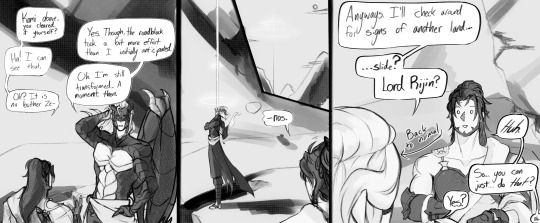
A bit of community service work to repay his third chance leads to Hien witnessing Zenos' own special brand of weird.
#ffxiv#sketch#digital art#zenos yae galvus#hien rijin#adventurer zenos#I have finally sat down to learn how to draw the porcupine + his outfit and I will now unabashedly misuse this new power#aka stuff for the au amongst other things#where hien reluctantly gives zenos a chance to prove himself#only to find out hes surprisingly efficient with a strong sense of work ethic- *if* he actually cares about the work hes doing#not at all anticipating that might involve him turning partially into shinryu just to get a bit more utility#and that to redisperse the aether into the surroundings zenos is very carefully making sure the laser is not going to hit anything#I also like to think that once zenos starts learning to respect more than WoL that he is just shockingly polite to people#even if that means when hes listening he is just ***Staring***#->Lyse+Hien+Yugiri also getting unabashedly praised- Lyse especially- when he learns more about Ghimlyt#following in WoL's footsteps I like to think he'd *try* to form good relationships with leaders and people he meets-#-even if much of it involves attempted murder towards him only for him to go “hey- I can't die. let me do something else for it”#also completely unrelated but I just want minstrel's ballad:shinyru to be the canon version of the fight#I adore how absolutely unhinged that fight is#dog farming meant my entire fc got to sprint across his back and sit on his shoulders before he lobbed us all off#because he was stubborn#and hated dropping the mount for any of us
38 notes
·
View notes
Text
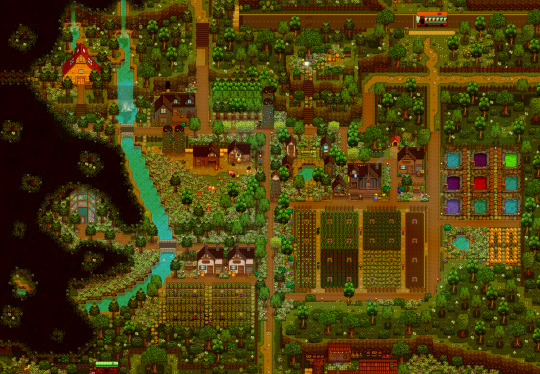

some day and night shots of my SVE farm on summer 28, year 4 :]
#i say stuff#stardew valley#stardew valley expanded#stardew valley farm#i played on this farm obsessively more than a year ago#i was waiting for SVE to be updated and now SV is gonna get a 1.6 update sometine soonish#i think i read somewhere that the creator of SVE is waiting for 1.6 to drop to update the mod??#anyways right now i'm just grinding the money to get the golden clock and get 100% completion on this farm#i Could be more money efficient and only plant super expensive crops buuuuuut i like it when my farm looks nice lol
28 notes
·
View notes